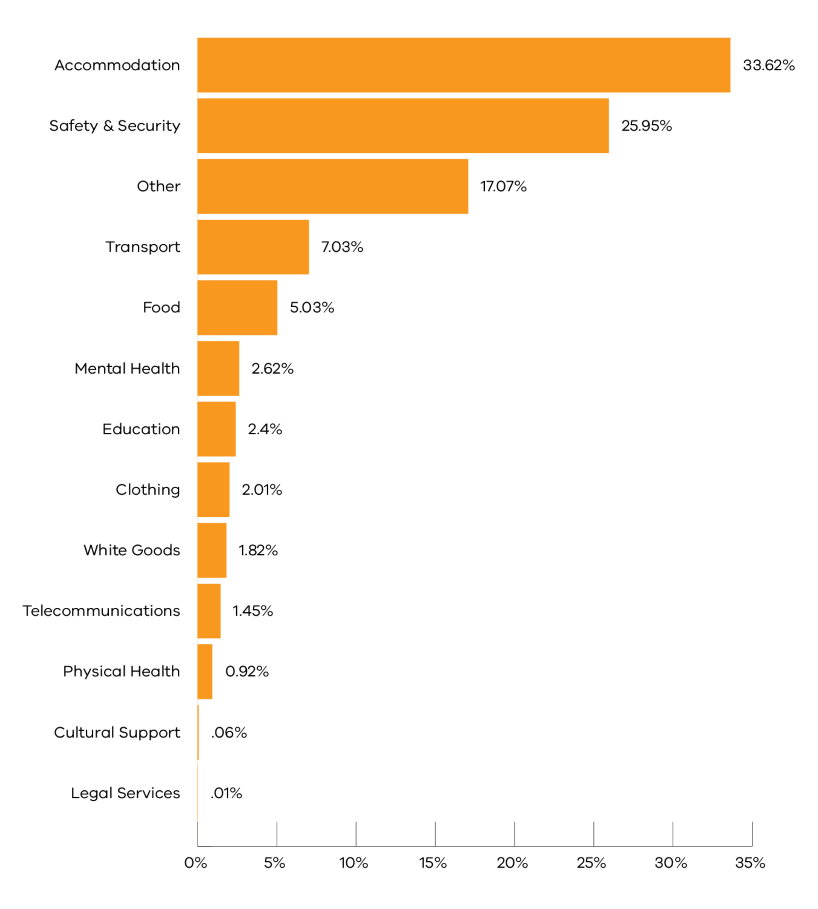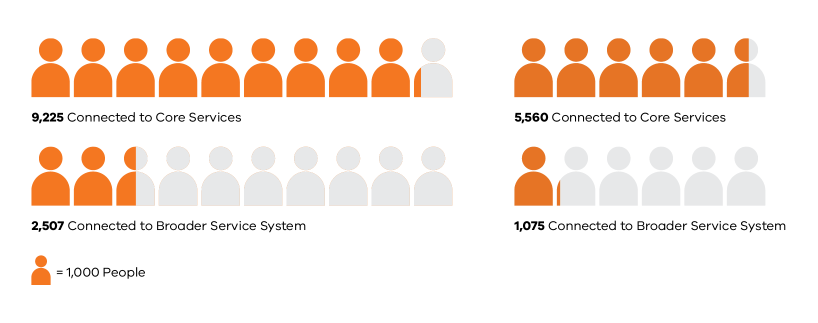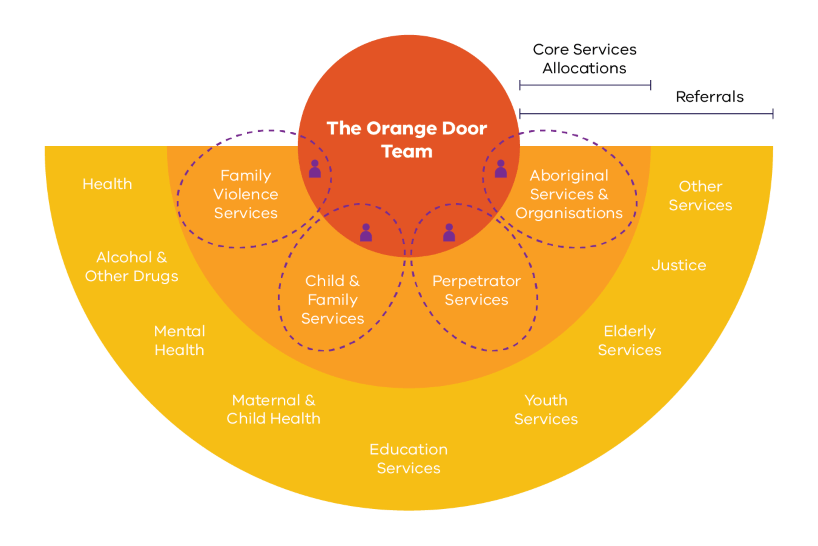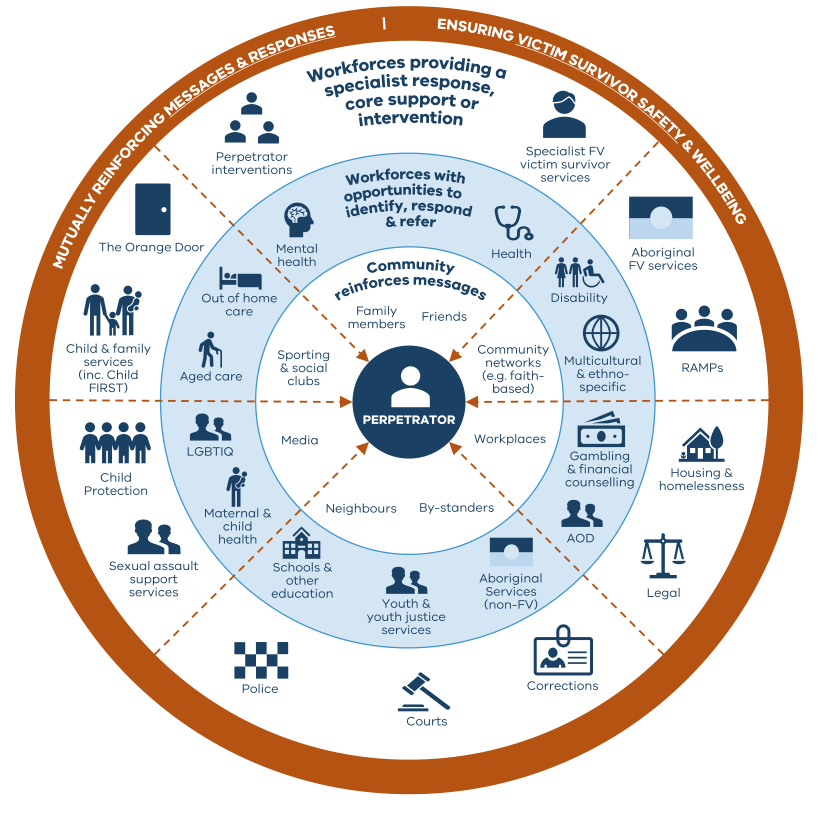As a key entry point to the service system, The Orange Door assesses need, and manages risk, develops safety plans, supports people to get the support they need by connecting them to relevant services, as well as providing crisis responses where needed.
What immediate supports does The Orange Door provide for individuals and families?
The Orange Door provides crisis intervention, supported through brokerage funds. Brokerage funds are available to individuals and families accessing services through The Orange Door network, providing quick and flexible support to meet immediate needs, and reduce risk. The Orange Door network recorded providing 14,151 crisis responses and short-term interventions in 2019-20 (compared to 4,313 in the previous year), with 3,381 of these supported through use of brokerage support.[4]
Figure 10 shows a breakdown of the brokerage used by purpose during 2019-20 and Figure 11 shows the breakdown of expenditure by type of support purchased. Accommodation and safety/security related items continue to be the largest proportion of brokerage expenditure, and predominantly are utilised to reduce risk or avert further crisis and can be accessed immediately upon the need being identified. Proportionally, accommodation and safety/security-related items are also typically a higher cost per unit, with an average $650 - $750 per episode (as opposed to food, transport or clothing for which average spend is $125 - $250 per episode). Brokerage is often utilised for these needs as it is:
- able to be activated quickly
- flexible enough to meet the required cost to meet the identified need (as opposed to other crisis and emergency funding supports available in the service system which have fixed limits or take time to process).
This is why this support option is so important in being able to be directly provided to clients of The Orange Door.
Figure 10. Brokerage supports by category 2019-20
Figure 11. Brokerage supports by description 2019-20
For people experiencing family violence, safety planning is one part of risk management that is also undertaken by The Orange Door as an immediate support intervention. It typically involves a plan developed by a practitioner with the victim survivor to help manage their own safety in the short to medium term. Practitioners in The Orange Door recorded 6,129 safety plans in the CRM to help keep victims of family violence safe in 2019-20, a 77.3% increase from 2018-19.[5]
How is The Orange Door working to connect people to services to meet their needs?
One of the key functions of The Orange Door network is to connect individuals and families to the services they need. The process of connecting an individual or family to a service is done either by ‘allocation’ to a core service - when a client is provided with a family violence service, family service, men’s perpetrator service, or an Aboriginal service, or by a ‘referral’ to broader services - when a client is supported to access any other service (outside of the core services e.g. broader services such as housing or mental health support) (Figure 12). In 2019-20, The Orange Door allocated a core service response to people 9,255 times and connected people to broader services 2,507 times (Figure 4).
The Orange Door made 11,762 allocations of core services and connections to broader services in 2019-20, 77.3% higher than the previous year.
Compared to 2018-19, the number of people who were provided a response by The Orange Door network increased by 16.5% and the number of children who were provided a response increased by 17.2%. Compared to the total number of people provided a response, the proportion of children provided a response was similar in each financial year (38.7% in 2019-20 and 38.4% in 2018-19).
The number of times core service responses were allocated to people who had accessed The Orange Door increased by 66.5% compared to 2018-19, with people connected with broader services 2.3 times more (2,507 times compared to 1,075 times) than in 2018-19. This partially reflects recording within the CRM of these connections.
Figure 12. Number of times people were connected to services in 2019-20 compared to 2018-19
Figure 13. The connection of The Orange Door to the broader service system
The Orange Door team is an integrated team of specialists from organisations delivering family violence victims and perpetrator services, child and family services, Aboriginal services and community-based Child Protection.
The Service System Navigator for each area plays an important role in establishing and maintaining these local connections, including through practice interface agreements. This work includes strengthening access and responsiveness to diverse communities.
We are seeing important and significant steps towards better collaboration between different parts of our service system, with a shared understanding of the broader contexts of family violence and family services, including safety and wellbeing risk factors for children and young people and diverse cohorts. The expansion of MARAM in 2021 across a wider range of professionals and sectors will serve to further enhance this collaboration and improve our identification of risk and responses to people experiencing family violence.
Perpetrator accountability and the role of The Orange Door
The family violence service system is progressively tilting the focus to perpetrator accountability, and responses to perpetrators are maturing – to increase perpetrator engagement, visibility, and accountability. The Victorian Government’s Family Violence Rolling Action Plan 2020-23 includes a priority focus on perpetrators and articulates a whole-of-Victorian Government work program to strengthen perpetrator accountability. This work program is led by, and builds on, the vision of a strong ‘web of accountability’ articulated by the Royal Commission into Family Violence and the Expert Advisory Committee on Perpetrator Interventions (Figure 14). The web includes the people, groups, services, and systems that must work together to form a cohesive system to engage with and influence a perpetrator’s behaviour to achieve perpetrator accountability.
The Orange Door – along with CIP, MARAM Framework and FVISS – plays a critical role in this web of accountability, improving system coordination and the sharing of risk-relevant perpetrator information.
Figure 14: Web of accountability
[4] Note that this is likely to be an underestimate due to the transition from manual recording to electronic capture of episodes of brokerage during 2019-20
[5] The count of safety plans is likely to be an underestimate, as they may be created and documented in ways that meet the needs of the victim survivor. This may mean that the format and recording used needs to vary from the base template housed within the CRM, such as being documented within a more comprehensive case plan for the individual or in an accessible format. The safety plan templates within the Client Record Management system have subsequently been updated to be consistent with the MARAM practice guides and were made available for practitioner use in late 2020, with further development taking place into 2021.
Updated




